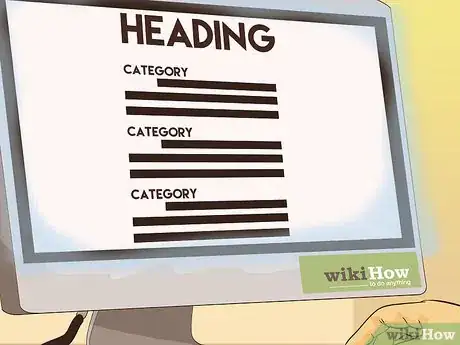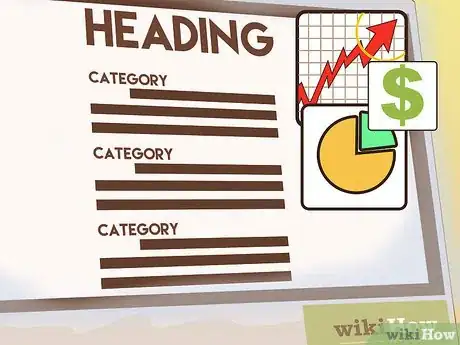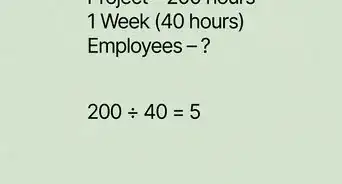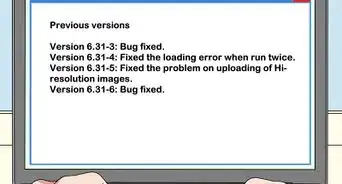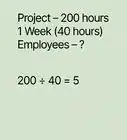This article was co-authored by wikiHow Staff. Our trained team of editors and researchers validate articles for accuracy and comprehensiveness. wikiHow's Content Management Team carefully monitors the work from our editorial staff to ensure that each article is backed by trusted research and meets our high quality standards.
wikiHow marks an article as reader-approved once it receives enough positive feedback. In this case, 86% of readers who voted found the article helpful, earning it our reader-approved status.
This article has been viewed 184,369 times.
Learn more...
A project management report is a document that describes a business project and the steps a team should take to complete it. The report is shared with the project's key players. When everyone is on the same page, everyone can work together to complete the project's goal. The report typically contains the project plan, the team's responsibilities, a projected timeline, and a budget. With organization, clarity, and the input of your team members, you can easily create an effective project management report and work toward completing its goals.
Steps
Collecting the Information
-
1Define the project's purpose. A project management report should outline the project's scope and end goal. Understanding the objective is key to comprehending the needs that this project hopes to meet. It is important for you and your audience to have a clear notion of the project's purpose to maximize the effectiveness of your report.
- Ask yourself, “How will this help my company, our client, or our community? Will this project possibly have a positive impact in other areas?”
- Understanding the overall scope may help you appreciate how this project may be useful to you and others.
-
2Pinpoint your audience. Know who will be reading the report and what they may wish to learn from it. Some details may be extraneous to certain audiences, while others may need to be provided with detailed information. Identifying your readers at the outset will provide direction for the project report content.
- Some audiences may not be familiar with the language, terms, and jargon often used in your working environment.
- If you are writing a report for a client, for example, avoid using technical jargon that requires lengthy explanations.
- Instead, plan to write in a voice that easily describes your project scope and timeline.[1]
Advertisement -
3Create a table of contents. A table of contents essentially provides an easy-to-read outline for your audience. At a quick glance, a reader can quickly understand the structure and substance of the document.[2] A table of contents can also help busy readers find the information that is significant to them quickly and effectively.
- Perhaps an investor is reading the report to review the budget. Showing where the budget is in the table of contents will help them find what they need fast.
-
4Talk to your supervisor. Have a meeting with your supervisor to understand the expectations of your project management report. Your supervisor may have particular points of interest, concerns, or details that they would like for you to include in the report. Try to collect as much useful information as you can to help make your report clear and useful.
- Your supervisor may also explain how long the report should be and if there are particular formats that your company requires for these types of reports.
- Ask your supervisor about what to include in the report. Your supervisor will appreciate the opportunity to give you feedback early in the process.
Formatting and Writing the Report
-
1Provide an executive summary. The executive summary is presented at the beginning of a project management report. This summary gives the reader a concise overview of the project's purpose and the team's findings, progress, anticipated obstacles, and timeline. Readers should be able to review the summary and understand the overall process of the project.
- Concisely summarize the importance of the project and its main objective. “This project will expand our client's impact in their market by fulfilling this unmet need in this field.”
-
2Write an introduction. An introduction should describe the nature of the project, it's overall goal, and the project's value to the company, client, or community.
- Be as succinct as possible without sacrificing necessary details. Try to convey your message in a couple of sentences or bullet points instead of lengthy paragraphs.[3]
- If you are publishing a book, for example, list significant information such as “book tour slated to begin in September” and "holiday sales expected to increase by 15%."
-
3Explain key data in a methodology section. You should provide data that describes relevant statistics and qualitative observations that inform the needs of your project. Make it easy for the reader to understand why your project is important, how it is uniquely suited to answer a particular problem, and how it will answer or meet your company's needs or client's requests.
- If your project goal is to help a company open a fashion store in a particular area, for example, provide data that describes the nearby competition.
- Data on the market and competition can help the reader understand that there is an opportunity to meet a particular need.
-
4List the resources needed for the project. Describe the manpower, tools, and resources being utilized to achieve the goals of the project.[4] Use this section to briefly describe which departments are in charge of particular aspects of the plan and what programs or information they are using. This section can also describe any elements of the project that are being outsourced. The reader should be able to understand who is in charge of certain deliverables.
-
5Provide a projected or allotted budget. Provide a chart or graph that demonstrates the details of the budget and describes where the funds are going. Note if the projected budget is adequately funding the project resources. It is also important to include whether or not the project will be completed within the allotted budget.
-
6Include a project timeline. Describe how long it will take to complete your project and include all relevant project milestones. In this section, you may also wish to include the overall health of the project and how it is progressing. Make it easy for the reader to quickly understand your project's status.
- If you are in the middle of a project, include a percentage that describes the project's completion and whether or not you are ahead of schedule.[5]
-
7Describe project challenges and provide solutions. Your project may run into anticipated challenges or unexpected setbacks. Challenges might include insufficient resources, unexpected obstacles, mechanical or technical failures, or other delays. Describe solutions and briefly explain what is needed to remedy the project challenges.
- If there is an anticipated delay, state it in this section.
- You might say, “Construction on the new building may slow significantly during January as the frigid temperatures may create unsafe working conditions.”
- Let your reader know that you have adjusted the timeline to account for such anticipated delays.
-
8Crafting the report conclusion. Use the conclusion to briefly remind the reader of the most important issues and the project's objective. Focus on your project's forward momentum and goals in the conclusion.
- Remind your reader what is needed going forward.
- You could write, “With the timely support of our donors, the project should be completed on time and under budget by next May.”
- Highlighting the needs can help ensure that the project is completed on time.
Polishing Your Report
-
1Use formatting techniques to guide the attention of readers. Provide clear categories with subheadings and bullet points throughout the report to save time for readers who are only interested in certain aspects of the project document.
-
2Make the report visually interesting. Using graphs, charts, and other figures throughout your report can help demonstrate key points, reduce repetition, and provide visual interest for the reader. Label each graph and provide an easy-to-read key.
- Save the reader some time and place the figures alongside relevant portions of the text instead of at the end of the report.
- The reader will be able to easily review both the text and the chart without having flip through the pages.[6]
-
3Circulate the preliminary report to your project team members. This is a particularly important step before distributing the project report to other departments, management, or your clients. Team members may draw your attention to important details that are missing. They may also help point out sections that are unclear and are difficult to understand.
- Revise the report to include contributions from team members. Use your judgment regarding which details to include.
-
4Proofread the report. Your report should be clean, clear, and free from formatting issues and spelling and grammar mistakes. A well-organized and error-free report will reduce distractions and allow your readers to focus on the main points of your report. Reading the same document multiple times can cause you to overlook some obvious mistakes, so ask a team member to proofread the document.[7]
Community Q&A
-
QuestionHow do I write an internship report?
 Community AnswerAn internship report is a written account of a person's experience during an internship. The overall goal is for the student to demonstrate what they learned during their time as an intern. These reports are usually submitted for academic credit. Each institution and program has guidelines for these reports. Talk to a professor, a student advisor, or an academic advisor to understand what your program requires for your report.
Community AnswerAn internship report is a written account of a person's experience during an internship. The overall goal is for the student to demonstrate what they learned during their time as an intern. These reports are usually submitted for academic credit. Each institution and program has guidelines for these reports. Talk to a professor, a student advisor, or an academic advisor to understand what your program requires for your report. -
QuestionI represented my company at an off-site program. How can I summarize my experience in a report?
 Community AnswerIf you have represented your company in an outside program, your supervisor may wish for you to report on your experience. Begin by describing the program or event and why you were there to represent your company. Explain what you did during your time at the program. Did you give a presentation? Did you answer questions at a booth? Conclude by describing your interactions and any feedback you received from others at the event.
Community AnswerIf you have represented your company in an outside program, your supervisor may wish for you to report on your experience. Begin by describing the program or event and why you were there to represent your company. Explain what you did during your time at the program. Did you give a presentation? Did you answer questions at a booth? Conclude by describing your interactions and any feedback you received from others at the event.
References
- ↑ http://www.brighthubpm.com/monitoring-projects/6034-typical-project-management-reports/
- ↑ http://www.brighthubpm.com/templates-forms/93013-ten-tips-for-creating-effective-project-reports/
- ↑ https://www.projectsmart.co.uk/how-to-report-status-on-a-project.php
- ↑ http://www.brighthubpm.com/monitoring-projects/6034-typical-project-management-reports/
- ↑ https://www.projectsmart.co.uk/how-to-report-status-on-a-project.php
- ↑ http://www.brighthubpm.com/templates-forms/93013-ten-tips-for-creating-effective-project-reports/
- ↑ http://www.brighthubpm.com/templates-forms/93013-ten-tips-for-creating-effective-project-reports/
- ↑ https://www.teamgantt.com/guide-to-project-management/how-to-plan-a-project/
About This Article
A project management report describes a project and the steps your team should take to complete it. Start your report by outlining the purpose of the project and what it seeks to achieve. You’ll then need to list the resources needed to finish the project, including manpower, tools, and products. Provide a projected budget to show how much it will cost and if you need to secure any extra funding. Include a timeline to show how long the project will last and when you’re likely to hit major milestones. You should also detail any challenges the project is likely to face and how you will solve those problems. When you’ve finished drafting your report, ask for feedback from your major team members in case there’s anything significant it’s missing. For more tips, including how to format your project management report, read on!












